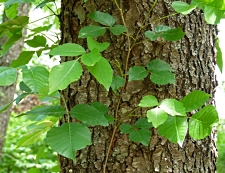Wildlife - Species

Poison Ivy (Toxicodenrum radicans)
Description
Poison ivy belongs to the cashew family (Anacardiaceae). The species is easily recognized by its leaf structure and adventitious roots. The leaves of the liana (woody vine) are deeply dissected into three thin leaflets that are hairy along the veins on the underside. The leaflet shape ranges from ovate to elliptic, with margins that are entire, shallowly lobed or serrated; usually all three margin types are found on one plant. Their tips are pointy, and the bases are rounded. Leaflet size is variable, ranging from 5-20 cm (2 to 8 in) long and 2-12 cm (1-5 in) wide. The flowers are monoecious (individual flowers have either male or female flower parts). Male flowers (contain stigma, the pollen-producers) and female flowers (contain pistils, seed producers) are greenish-white to cream and about 0.6 cm (0.25 in) across.
Preferred Habitat and Biology
Poison ivy is found throughout the southeastern United States (Virginia to Florida and west to the Mississippi River) where it grows in all types of communities, ranging from open areas to forests, as well as in disturbed sites such as ditches and roadsides. Poison ivy prefers shady, damp places such as mesic forests and swamps, but it is also a common species in maritime forests such as those in the ACE Basin.
The plants produce flowers in April and May, and various insects transport the pollen from the male flower to the female flower. The fruits mature in August and September, and the seeds germinate in the spring of the following year. Seedlings use adventitious roots to attach themselves to trees, rocks, and buildings. The plant also attaches to cypress “knees” (aboveground roots), and when it reaches the top of the knee, it branches out laterally, forming a dome-shaped growth over the cypress knee. When no host is available, poison ivy creeps along the ground.
Species Significance
It is estimated that 70% of the population in the United States is sensitive to the oil produced by the leaves and stems. The oil, urushiol, causes painful rashes and blistering of the skin. However, its fruit is popular with wildlife. The fruit is consumed by many kinds of birds, particularly during the winter when other sources of food are scarce. In the Southeast, catbirds, Carolina chickadees, and wild turkeys are known to feed on it. The fruit is also consumed by several species of songbirds and a few mammals, who also eat the stems and leaves, including the black bear, wood rat, and mule deer.
References
Martin, A.C., H.S. Zim, and A.L. Nelson. 1951. American wildlife and plants: A guide to wildlife food habits. Dover Publications Inc., New York, NY.
Porcher, R.D. 1985. A field guide to the Bluff Plantation. Kathleen O’Brien Foundation, New Orleans, LA.
Radford, A.E., H.E. Ahles, and C.R. Bell. 1968. Manual of the vascular flora of the Carolinas. The University of North Carolina Press, Chapel Hill, NC.
